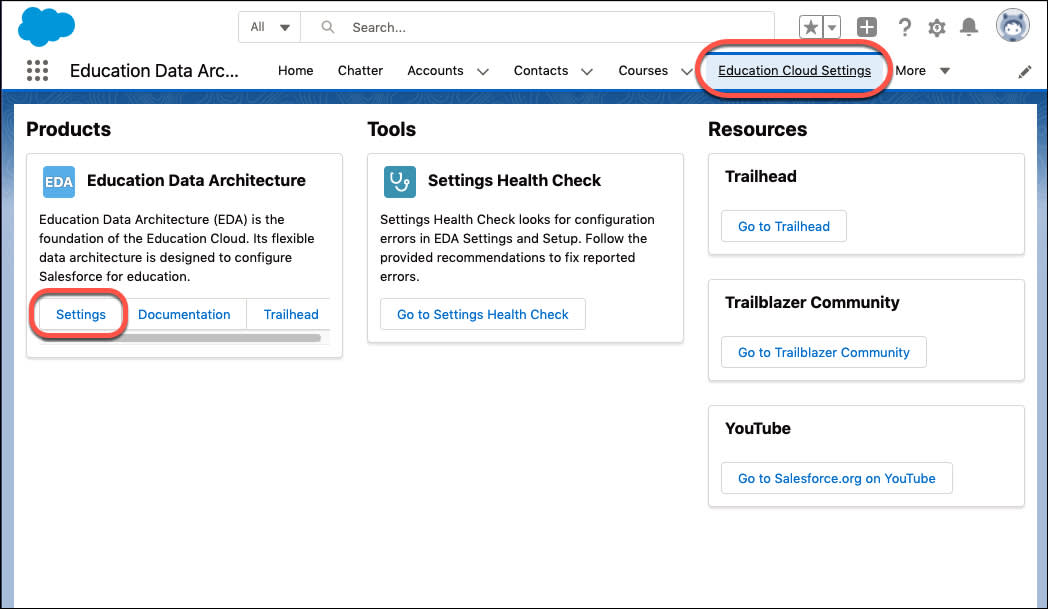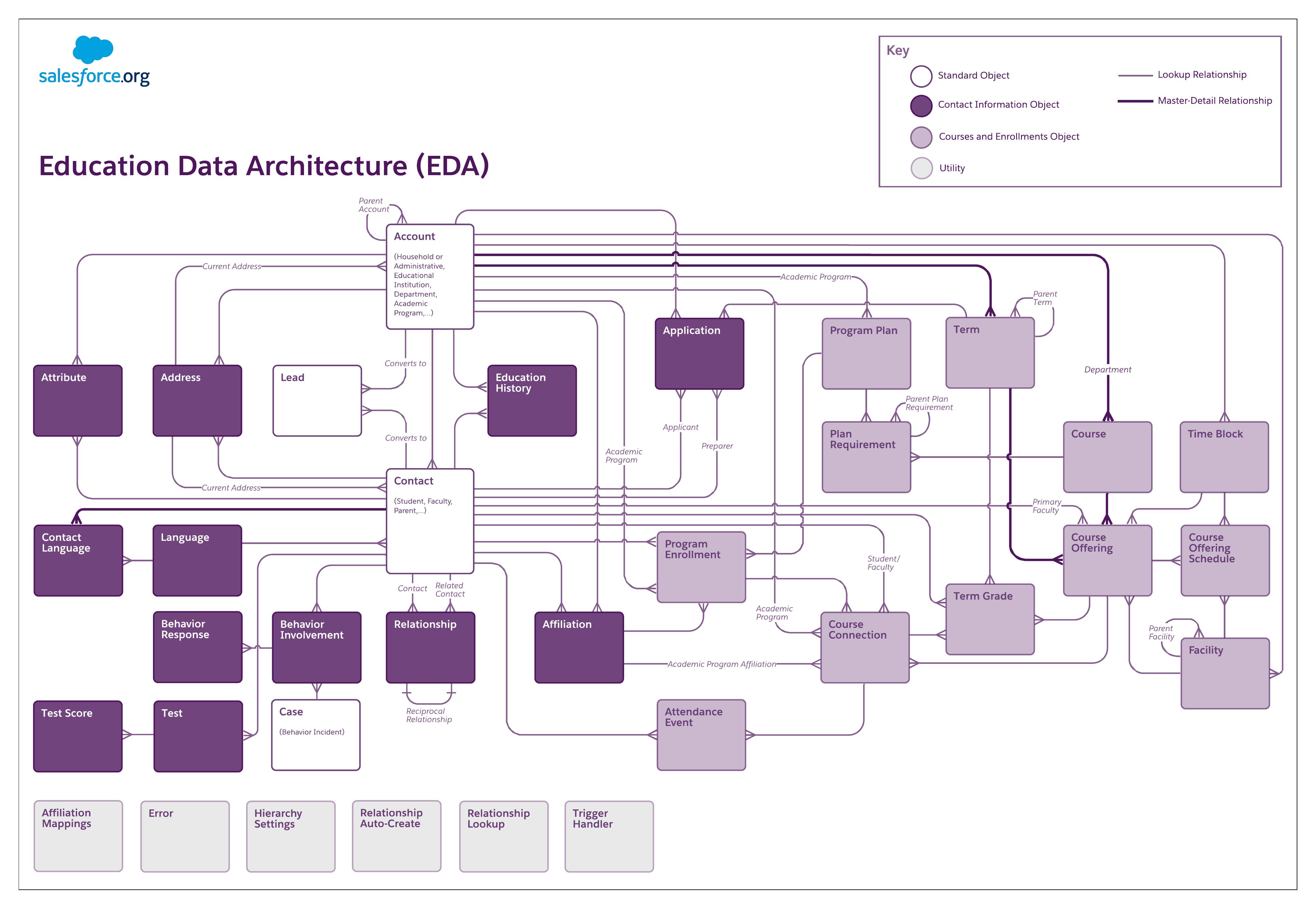Get Comfortable with EDA Settings and ERD
Learning Objectives
After completing this unit, you’ll be able to:
- Get to know EDA Settings and basic settings navigation.
- Describe the Entity Relationship Diagram (ERD) for EDA.
A Tour of EDA Settings
EDA Settings contain all kinds of useful information that will help you configure specific objects to your educational institution’s unique needs. Because EDA is so customizable, understanding what’s in EDA Settings and how to best use them to serve your school community’s needs will be critical to your work as an awesome admin. In this unit, we tour the navigation of EDA Settings, review some need-to-know terminology, and introduce you to the Entity Relationship Diagram (ERD). Once you feel confident in these EDA Settings fundamentals, you can check out an entire module dedicated to a more detailed exploration of EDA Settings and best practices. It’s the next module in this trail and it’s also linked in the Resources section at the end of this unit.
Nina Brown of Cloudy College is an experienced education admin who knows a thing or two about EDA Settings. As luck would have it, she’s agreed to show us around. If you've installed EDA in a production org or Trailhead Playground, you can log in and follow along. Follow these steps to navigate to EDA Settings and start your configuration journey.
- Click the Education Cloud Settings tab on the Home Page.
- If you don't see the tab on your Home Page, it may be nested under More. You can also navigate to Education Cloud Settings from the App Launcher by searching for and selecting Education Cloud Settings.
- Under Products, find Education Data Architecture, and click Settings.

Lots of features come standard in EDA (aka “out-of-the-box”) but there are also decisions you get to make so EDA works best for you and your institution. That’s where EDA Settings come in. EDA Settings offer a guide to get you started, so use them to guide key configuration decisions to make sure your Salesforce org is configured correctly for your institution.
To further help guide your decision making, it’s worthwhile to get to know some of the critical objects that come standard in EDA and how all of those objects are interconnected. Nina created this settings terminology cheat sheet for herself when she was first learning how to navigate and configure EDA. She agreed to share it in hopes of helping her fellow education admins. You’re the best, Nina!
| EDA Settings Section | What settings will I find here? | What are some configuration highlights? |
|---|---|---|
| People and Groups |
|
Accounts and Contacts are crucial to EDA—respectively these represent the things that happen at an institution (academics, sports, clubs, and more) and the people (students, faculty, administration). There’s a lot going on in the People and Groups settings that we’ll dive into in a later module. For now what you need to know is that this is where you can control certain elements related to accounts and contacts, like default language fluency, and where you configure preferred email and phone number. |
|
Affiliations |
|
Affiliations are all about connecting contacts to accounts. Use Affiliations settings to define default roles and statuses and program enrollment deletions. |
|
Relationships |
|
Relationships are all about connecting contacts to other contacts. Use Relationship settings to define and create reciprocal relationships (spouse to spouse, for example) and enable automation around relationship creation. |
|
Courses and Enrollments |
|
Course Connections are used to track a student’s enrollment in a Course Offering. Use these settings primarily to enable Course Connections, and to set your default record types for students and faculty. |
|
System |
|
System settings are not to be missed! This is where you update error handling settings and use System Tools to make updates to records across your org. |
Being well-versed in EDA terminology will help you make decisions with more confidence when configuring for your particular institution. Now onto some more new lingo that will be useful to mastering EDA Settings: The Entity Relationship Diagram.
The ERD Basics
The Entity Relationship Diagram (ERD) provides a helpful overview of all of the objects at your disposal within EDA, and how they relate to each other.
There’s quite a bit of EDA info represented in the ERD so let’s take a moment to study it.
Note that there are four different object types represented:
- Standard Objects
- Courses and Enrollments
- Contact Information
- Utilities
In addition, there are two relationship types represented:
- Lookup Relationships
- Master-Detail Relationships
In a master-detail relationship, there is a direct dependency between objects. If you were to delete the master record, it would trigger a cascade deletion of any record that shares the master-detail relationship. A lookup relationship is a bit more casual. Lookup relationships are used to link two objects together when it’s not necessary or ideal to have the behavior of the master-detail relationship, particularly in the context of sharing rules, profile permissions, and that cascade delete mentioned above.
Understanding the objects and how they are interrelated not only helps you better understand how and where data flows within EDA, it’s also useful when building reports (much more on reports later).
Object Overview
Objects organize information around people and activities that happen within an educational institution at every stage of the student lifecycle. You’ll notice that the ERD organizes data around two important objects: Contact and Account. These two objects are linked within Salesforce. Contacts host information related to constituents like students, faculty, and alumni. Accounts function as containers and organize information around households, educational institutions, departments, and academic programs, among others.
When Nina first learned EDA, she was really excited about how specific and tailored these EDA objects are to the education experience. But she was admittedly a bit overwhelmed by the ERD. So, she created another cheat sheet to help her think about which EDA objects may be most applicable to the work being done in particular departments at her institution. Check it out below.
|
Department or Group |
Useful EDA Objects |
|---|---|
|
Recruitment and Admissions |
|
|
Academics |
|
|
Student Experience |
|
|
Advancement |
|
This isn’t an exhaustive or restrictive list, it’s just a quick reference resource that Nina created when studying the ERD and making connections between what she has access to in EDA and how it can be used to help with configuration in different areas of her institution. We think you’ll find some overlap with your work and we encourage you to make your own quick reference to fit your school.
Knowledge Check
Ready to review what you’ve learned about EDA Settings? The knowledge check below isn’t scored—it’s just an easy way to quiz yourself. To get started, match each EDA Settings section to the corresponding configuration task(s) that can be done in that section. When you finish matching all of the EDA Settings sections to configuration tasks, click Submit to check your work. If you’d like to start over, click Reset.
Great job! You’ve reviewed EDA Settings and the configuration tasks you can complete in each respective section. And with that, it’s a wrap on Nina’s high-level review of EDA Settings. Hopefully you find the resources she shared helpful. Want to learn more from the expert? Meet Nina in the next unit for an introduction to the EDA account model.
